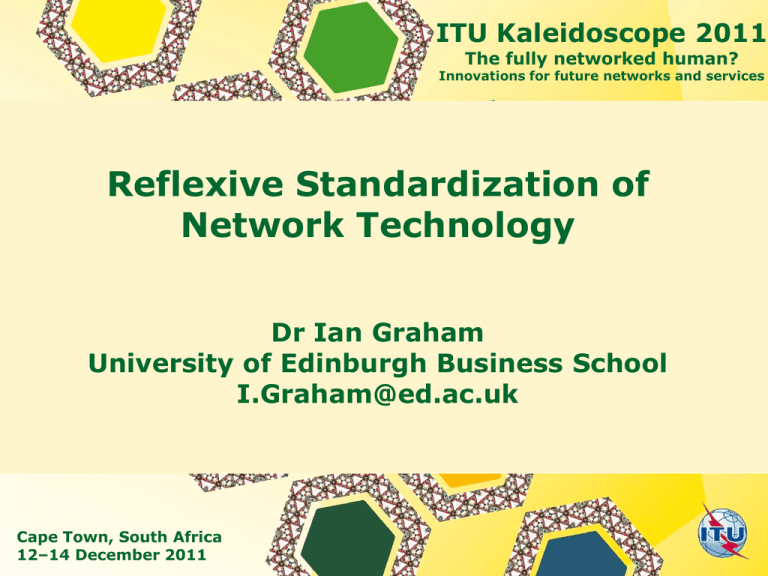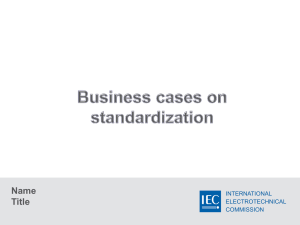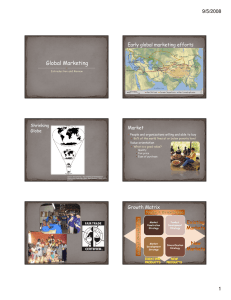Reflexive Standardization of Network Technology ITU Kaleidoscope 2011 Dr Ian Graham
advertisement

ITU Kaleidoscope 2011 The fully networked human? Innovations for future networks and services Reflexive Standardization of Network Technology Dr Ian Graham University of Edinburgh Business School I.Graham@ed.ac.uk Cape Town, South Africa 12–14 December 2011 Agenda Emergence of new standardization forms A case of Internet of Things standardization: ISO IEC JTC1 SC31 WG6 The emergence of reflexive cosmopolitan processes of standardization Internet of Things Internet of Things Standardising the Internet of Things Internet of Things depends upon standards Maximise network effects Avoid platform wars Convergence of technologies implies a convergence of standardization processes Research Questions How do standards processes/organisations form in new areas? Why are “standards wars” so rare? “Modern” Standardising In the beginning: variety reduction Driven by needs of users National standards bodies created to develop national standards: BSI, ANSI, DIN etc. Participation by experts Consensus decision making Creation of international bodies, based on national representation. “Reflexive” Standardising Driven by technology development Developers collectively choose a home for their standardization Formal v consortium Local v global Open processes This is “late modern”. A case of IoT standardization: ISO IEC JTC1 SC31 WG6 ISO IEC JTC1: joint formal process of International Organisation for Standardization and International Electrotechnology Commission set up in 1987 SC31 established in 1996 for RFID standardisation WG 6: Mobile Item Identification and Management established in 2007: driven by Korean research centre and US participant to develop mobile phone RFID interfaces. Scope of WG6 “Standardization of automatic identification and data collection techniques that are anticipated to be connected to wired or wireless networks, including sensor specifications, combining RFID with mobile telephony, and combining optically readable media with mobile telephony.” Definition of scope is in terms of technical functions rather than application, although scenario of “concert poster” frequently referred to in meetings. These are “anticipatory standards”: the user does not yet exist… Process WG6 process draws legitimacy from adopting the institutions of global formal standards development; Links to users are tenuous; Representation of experts problematic: do they represent themselves, their countries or employers? National interest difficult to identify: Rise of transnational corporations Globalisation of technology market Difficulty in defining user. Modern v Late Modern Divide Inside the border Standards development defined technically Develop standards to meet the functional requirement Reuse elements from outside Along the border Discussion of scope Liaisons with other standards bodies Maintenance of legitimacy Avoidance of conflict Skirmishing Cosmopolitan Outlook “ a global sense, a sense of boundarylessness. An everyday, historically alert, reflexive awareness of ambivalences in a milieu of blurring differentiations and cultural contradictions” Ulrich Beck, 2006. Participants in WG6: had a national affiliation; but most did not speak to their country’s comments and some were not from their nominal country. Conclusion 1: Late Modern Standards Development Standardization processes are highly reflexive: Processes choose their institutional home; Processes focus on their own scope Focus on relations with other institutions and processes The process is cosmopolitan Participants see themselves as members of a global standards community Hollowing out of clear national interest National standards bodies struggle to identify a national interest Conclusion 2: Implications Enrolling users to participate in processes becomes difficult Enrolling users to participate in processes is not essential Transparency and communication between bodies limits potential conflict



